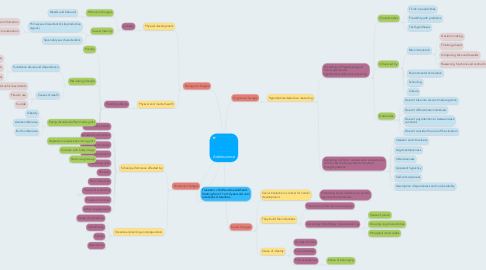
1. Emotional changes
1.1. School performance affected by
1.1.1. Self-efficacy beliefs
1.1.2. Academic motivation
1.1.3. Socioeconomic status
1.1.4. Parental involvement
1.1.5. Parenting styles
1.1.6. Ethnicity
1.1.7. Peer influences
1.1.8. Quality of schooling
1.1.8.1. Need of a stress-reduced environment
1.1.8.1.1. Avoiding mental disorder
1.1.9. Poverty in families
1.1.10. Active engagement
1.2. Vocational planning and preparation
1.2.1. Sense of ownership
1.2.2. Self-efficacy
1.2.3. Values
1.2.4. Aspirations
2. Transition: childhood to adulthood. Starting from 11 or 12 years old until late teens or twenties.
3. Biological changes
3.1. Physical development
3.1.1. puberty
3.1.1.1. Hormonal changes
3.1.1.1.1. Moods and behavior
3.1.1.2. Sexual maturity
3.1.1.2.1. Primary sex characteristics (reproductive organs)
3.1.1.2.2. Secondary sex characteristics
3.2. Physical and mental health
3.2.1. Health problems
3.2.1.1. Poverty
3.2.1.2. Risk-taking lifestyle
3.2.1.2.1. Substance abuse and dependance
3.2.1.2.2. Causes of death
3.2.1.3. Eating disorders (affect mostly girls)
3.2.1.3.1. Obesity
3.2.1.3.2. Anorexia Nervosa
3.2.1.3.3. Bulimia Nervosa
3.2.1.4. Depression (especially among girls)
3.2.1.5. Concern with body image
3.2.1.6. Not enough sleep
4. Cognitive changes
4.1. Hypothetical-deductive reasoning
4.1.1. According to Piaget's stage of formal operations: hypothetical-deductive reasoning.
4.1.1.1. Characteristics
4.1.1.1.1. Think in possibilities
4.1.1.1.2. Flexibility with problems
4.1.1.1.3. Test hypotheses
4.1.1.2. Influenced by
4.1.1.2.1. Brain maturation
4.1.1.2.2. Environmental stimulation
4.1.1.2.3. Schooling
4.1.1.2.4. Culture
4.1.1.3. Downsides
4.1.1.3.1. Doesn't take into account metacognition
4.1.1.3.2. Doesn't differentiate individuals
4.1.1.3.3. Doesn't pay attention to between-task variations
4.1.1.3.4. Doesn't consider the role of the situation
4.1.2. According to Elkind: adolescence inexperience with formal thinking leads to immature thought patterns.
4.1.2.1. Idealism and criticalness
4.1.2.2. Argumentativeness
4.1.2.3. Indecisiveness
4.1.2.4. Apparent hypocrisy
4.1.2.5. Self-consciousness
4.1.2.6. Assumption of specialness and invulnerability
5. Social changes
5.1. Social interaction is critical for normal development
5.1.1. Otherwise, social isolation can lead to dysfunctional behaviors
5.2. They build their identities
5.2.1. Peer presure from their social group
5.2.2. According to Kohlberg: moral reasoning
5.2.2.1. Sense of justice
5.2.2.2. Growing cognitive abilities
5.2.2.3. Principled moral codes
5.3. Sense of identity
5.3.1. Accept criticism
5.3.2. Self-awareness
5.3.3. Peer acceptance
5.3.3.1. Sense of belonging
